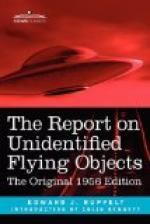The Pentagon Rumbles
On June 25, 1950, the North Korean armies swept down across the 38th parallel and the Korean War was on—the UFO was no longer a news item. But the lady, or gentleman, who first said, “Out of sight is out of mind,” had never reckoned with the UFO.
On September 8, 1950, the UFO’s were back in the news. On that day it was revealed, via a book entitled Behind the Flying Saucers, that government scientists had recovered and analyzed three different models of flying saucers. And they were fantastic— just like the book. They were made of an unknown super-duper metal and they were manned by little blue uniformed men who ate concentrated food and drank heavy water. The author of the book, Frank Scully, had gotten the story directly from a millionaire oilman, Silas Newton. Newton had in turn heard the story from an employee of his, a mysterious “Dr. Gee,” one of the government scientists who had helped analyze the crashed saucers.
The story made news, Newton and “Dr. Gee” made fame, and Scully made money.
A little over two years later Newton and the man who was reportedly the mysterious “Dr. Gee” again made the news. The Denver district attorney’s office had looked into the pair’s oil business and found that the pockets they were trying to tap didn’t contain oil. According to the December 6, 1952, issue of the Saturday Review, the D.A. had charged the two men with a $50,000 con game. One of their $800,000 electronic devices for their oil explorations turned out to be a $4.00 piece of war surplus junk.
Another book came out in the fall of 1950 when Donald Keyhoe expanded his original UFO story that had first appeared in the January 1950 issue of True magazine. Next to Scully’s book Keyhoe’s book was tame, but it convinced more people. Keyhoe had based his conjecture on fact, and his facts were correct, even if the conjecture wasn’t.
Neither the seesaw advances and retreats of the United Nations troops in Korea nor the two flying saucer books seemed to have any effect on the number of UFO reports logged into ATIC, however. By official count, seventy-seven came in the first half of 1950 and seventy-five during the latter half. The actual count could have been more because in 1950, UFO reports were about as popular as sand in spinach, and I would guess that at least a few wound up in the “circular file.”
In early January 1951 I was recalled to active duty and assigned to Air Technical Intelligence Center as an intelligence officer. I had been at ATIC only eight and a half hours when I first heard the words “flying saucer” officially used. I had never paid a great deal of attention to flying saucer reports but I had read a few—especially those that had been made by pilots. I’d managed to collect some 2,000 hours of flying time and had seen many odd things in the air, but I’d always been able to figure out what they were in a few seconds. I was convinced that if a pilot, or any crew member of an airplane, said that he’d seen something that he couldn’t identify he meant it—it wasn’t a hallucination. But I wasn’t convinced that flying saucers were spaceships.




